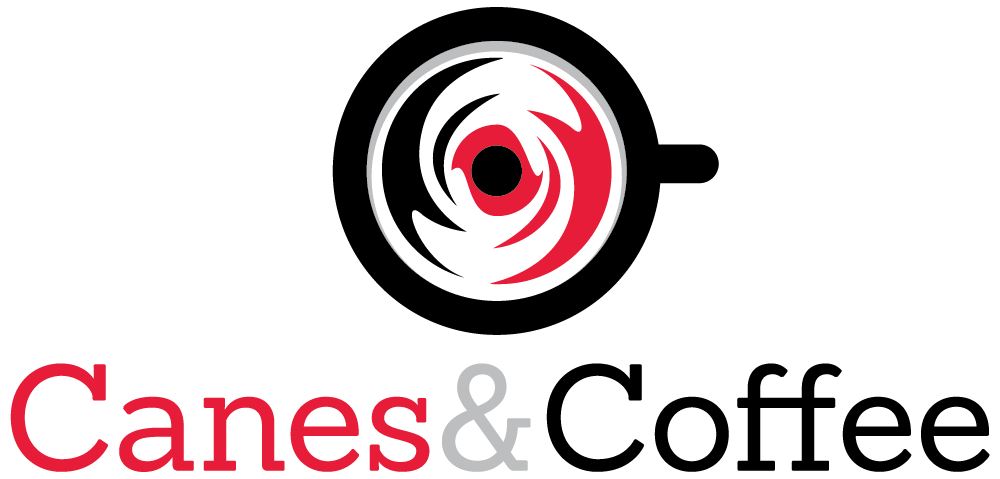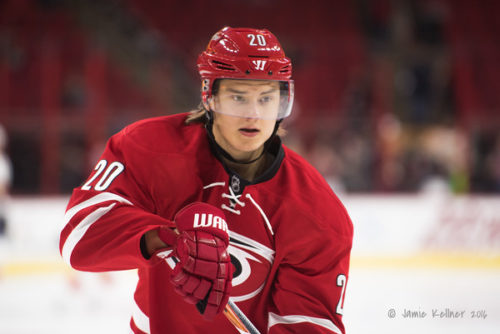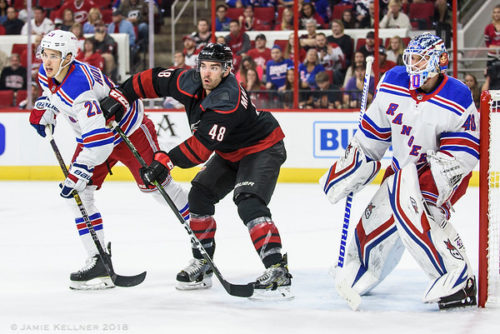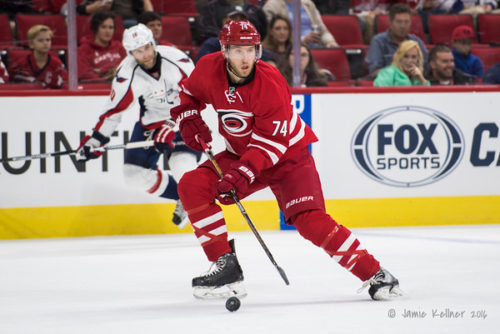Today the Carolina Hurricanes announced that the team had placed veteran fourth-line forwards Marcus Kruger and Josh Jooris on waivers with the intent of sending them to join the Charlotte Checkers in the AHL.
Covering two completely different ends of the spectrum, I am both surprised that it took this long and at the same time surprised that it happened at all.
Short version
The starting point for the season seemed to be building a veteran air tight defensive fourth line. That could work in a scenario where the Hurricanes find enough offense/scoring elsewhere. But there are two problems. First is that the Hurricanes are still struggling offensively and need to find goals wherever they can. Second is that the fourth line really has not proven to be a net positive defensively either. Virtually no scoring puts the ceiling at 0 for plus/minus, and the penalty kill that utilizes the fourth-liners has also been sub-par. The reaction is a bit delayed, but the move aims to put more offense in the lineup at the expense of the offense-lite veterans.
Best laid plans…
The move seems to finally scrap plans and strategy laid out and acted upon during the offseason.
In the press conference at the conclusion of the 2016-17 season, one of the overriding themes from Bill Peters’ comments was the need to add more NHL caliber players. He talked about this in the vein of higher-end players but was actually equally emphatic when talking about depth slots as well. Peters said, “The pieces need to come in to close that gap. If we think guys from the American League (AHL) are going to come in and close that gap, it’s not happening in my opinion as the coach.” He later followed that comment up by saying, “I don’t want to put a guy in a situation hoping without knowing. I want to know that he’s capable of playing that position. We have specific needs. If we can fill those specific needs, then you don’t have to jam a guy in there.”
The specific and comments and tone struck a decided tone for filling the bottom part of the roster with proven NHL players and not instead opting for an open try out with young players.
Though he did not fill the need (my opinion anyway) for a high-end offensive catalyst, Francis did work quickly and aggressively to build out the bottom part of the roster with proven NHL depth players. Only hours into the start of free agency, Francis signed Josh Jooris to a one-year contract. Three days later Francis acquired Marcus Kruger via trade from the Vegas Golden Knights. With Joakim Nordstrom and Brock McGinn already under contract and returning, the fourth line was more or less built out before the start of training camp.
After consecutive years that saw Peters struggle trying to hide defensive deficiencies match up-wise especially on the road, the moves seemed to give Peters a fourth line that he could trust in any situation and also offer a defensively capable line to go with Staal’s on the road.
The risk from the beginning
At a conceptual level, the benefit was a lineup that was more balanced and with less holes on the defensive side of the puck. The risk in my mind from the very beginning was that a team that finished 20th in the NHL in scoring for the 2016-17 season and needed to improve had just dedicated its fourth line to a group likely to be light on scoring. Couple with the fact that the team did not use its one big forward addition to add a scoring catalyst to the mix, and the the risky bet seemed to be that the team’s your players would simply find a higher gear in terms of offensive production.
I concluded my article assessing the Marcus Kruger trade by saying, “I am mixed on the direction that Jooris and Kruger indicate in terms of stocking a fourth line maybe entirely with scoring-lite checking line players.”
An okay beginning
Out of the gate, the plan launched okay. Skinner started hot, the team won at a reasonable even if not spectacular rate and as planned the fourth line added defensive depth and provided a group to play behind Staal’s in terms of match ups. And the newly-configured fourth line also passed the eye test being sound defensively and having decent success playing a possession game in their own end even if not generating much offensively.
The group’s offensive production was modest, but with Jooris’ two goals, the group of Nordstrom, Kruger and Jooris mustered 3 goals and 4 assists through 10 games in October. For a line not designed to score, the number was not great but was not horrible either given their intended role and deployment. In addition, the penalty kill that the fourth line largely manned started slow, but with Steve Smith still at the helm one had to figure that he would have that clicking in no time and back up to high levels of the past two years.
My rumblings begin modestly
In balancing patience with evaluating results early on, I initially questioned the general direction of the fourth line in my Daily Cup of Joe article on October 31 when I followed on my comments after the Kruger trade by saying, “I am mixed on the direction that Jooris and Kruger indicate in terms of stocking a fourth line maybe entirely with scoring-lite checking line players.”
Seeing early signs that the offense was not magically better with mostly the same players in October, in my daily post on November 6, I made my first call to reach to the AHL to at least try to find scoring help when I listed, “Reach to the AHL not just for depth but for meaningful offensive contributors” as one of three possible initiatives to find a scoring spark.
But the math never really worked
As the 2017-18 season progressed two situations quietly rose to the forefront in terms of assessing the fourth line and its ability to help the team win. First, probably not surprisingly, the Hurricanes offense that added only Justin Williams in terms of scoring help looked pretty similar to the 2016-17 offense that was just a notch or two away from being good enough. And at the same time, the scoring-lite fourth line strategy, while not horrible via eye test, was not really fulfilling hopes in terms of strengths that would drive wins. After a modest start with three goals in 10 games in October, Nordstrom, Jooris and Kruger notched only two goals in 13 games in November. The fourth line was not horrible defensively and to a reasonable degree fit the bill in terms of holding its own defensively, but one need not be a mathematician to know that the ceiling is zero in terms of plus/minus if a line never scores. In addition, the penalty kill which featured Nordstrom and Kruger as regulars was still unable to finds it way in the 2017-18 season.
At some point you need to move past what you think/hope will happen and evaluate based on actual results
Especially when trying new things, coaches must strike a balance between being patient and not making rash decisions based on small sample sizes and acting to make improvements.
Somewhere around the midway point of the season, I started the process of evaluating the results without being hindered by how I thought things might work.
At that time, two things continued to jump about about the fourth line as constructed and strategically used.
Lack of offense at a team level and the fourth line’s role in that: I initially questioned the fourth line and whether the plan was working in my Daily Cup of Joe on December 29. The general gist of that part of that article focused on the fourth line suggested that it might be possible to simultaneously improve the penalty kill and upgrade the team’s depth scoring.
Continued struggles on the penalty kill: Then in my Daily Cup of Joe for January 3, I did a deeper dive into the teams penalty kill woes and along the way noted Marcus Kruger and Joakim Nordstrom as the team’s two worst forward penalty killers in goals allowed per penalty kill ice time. Obviously reading Canes and Coffee (insert sarcastic face emoji), Peters has since decreased Marcus Kruger’s penalty kill ice time.
More of the same until kaboom!
As noted above, a short injury layoff for Marcus Kruger seemed to trigger a reduced role for him on the penalty kill even when he returned. But in general, Peters stayed the course in terms of stocking the fourth line with three offensively lite forwards with NHL experience and defensive acumen. The lineup flexed a little, but at the end of the day it was just Jooris, Kruger, Nordstrom and Di Giuseppe swapping in and out. Even when a Sebastian Aho injury opened a slot to possibly offer a try out to one of the players tearing it up offensively in the AHL, Peters was steadfast in sticking with proven NHL experience even if it continued to offer very little in terms of offensive production.
During a run of hockey that saw the Hurricanes winning at a reasonable clip and with the return of goaltending struggles consuming most attention, Peters continued on that course.
…Until it happened. “It” was a pair of horrendous weekend losses at home that came on the tail end of a longer streak of scoring challenges. The two lackluster losses prompted a fiery ultimatum from Bill Peters and a promise of lineup changes for the next game. In a Monday morning tirade, I similarly boiled over and offered a fairly drastic set of suggested changes before the next game on Tuesday. I called for one or two AHL call ups and more drastically a game in the press box for two key players (Skinner and Hanifin) and even went so far as to suggest that the team go ahead and elevate the tension level by making a captaincy change.
But after two days the boiling cauldron of a coach had been reduced to a simmer and another round of roster tinkering only at the very bottom of the lineup.
But another loss that saw the Hurricanes score only once for the sixth time in 10 games seems to have finally cajoled Peters into at least trying a change. The other shoe is yet to drop, but as of right now, the Hurricanes have only 11 forwards on the roster which suggests that the team is likely to recall and insert into the lineup at least one and possibly two players from the AHL.
So what’s next?
Max Pacioretty! I’m kidding. Though I will continue to annoyingly clamor for Francis to deal for the veteran scorer (from this morning BEFORE the waiver news) and while Thursday’s waiver moves could portend a trade, that is unlikely.
But will happen before the puck drop on Friday is the recall of at least one and probably two Charlotte Checkers’ forwards. At least one if not both of them should also draw immediately into the lineup.
There are a couple different directions that the team can go with the recalls.
With Kruger already playing a lesser role on the penalty kill and Jooris similarly in and out of duty, the Hurricanes have enough penalty kill options already in the lineup such that the player(s) inserted into the lineup do not necessarily need to also take on penalty kill roles. That means that the team can go either of two basic directions.
Option 1-Build a new fourth line with more scoring potential: Warren Foegele (21 goals/34 points including 4 shorthanded goals) and Lucas Wallmark (11 goals/31 points in only 30 games) could represent to bring in two defensively capable forwards somewhat from the same mold as the original plan albeit with significantly less NHL experience but also seemingly with much more offensive upside. In that scenario, perhaps Nordstrom adds a little more experience, and Peters is faced with the challenge of mustering the courage/confidence to regularly skate a line with two players with 12 (Wallmark) and 0 (Foegele) games of NHL experience. That route would also require either that Elias Lindholm return to right wing after playing center on Tuesday or Derek Ryan moving to right wing where he played some in 2016-17 but has not spent much time this season.
Option 2-Sprinkle in more offensive fire power into favorable situations: Arguably, the two players with the highest right now ceilings in terms of raw goal scoring ability are Aleksi Saarela and Valentin Zykov. Each player is producing at the AHL level right now (Zykov 23 goals; Saarela 18 goals), but each brings a completely different skill set. Zykov is more of a power forward with a nose for the net and propensity to create havoc at the top of the crease. He could fit well on a line with playmakers who can get the puck to the net and also as a net front presence on the power play. Saarela is a bit more from the mold of a skilled sniper with good speed and finishing ability. He could be benefit from playing on an uptempo line. If Saarela and/or Zykov were recalled they could slot somewhere in the top 9 and potentially provide a twofold scoring boost by scoring themselves and also pushing a higher-end offensive player down onto the fourth line.
Venturing a guess
Vote yourself, and see who readers expect to be recalled from the AHL in a poll in the Thursday Coffee Shop.
I could see the recalls being any combination of the four players mentioned, but if forced to venture a guess, my hunch is that the recall will be the two more defense-leaning/sound players in Foegele and Wallmark.
I am fine with this direction in general, but my concern is that if Peters recalls two players intended to play on the same line, in the pressure of crunch time, he might not have the courage to give them a real chance to make a difference.
What say you Canes fans?
1) Do you like the move to send two veterans down to make room for potentially higher scoring youth?
2) What would you do in terms of who you recall and even more importantly where they go in the lineup?
3) After mostly nothing on Tuesday, does this qualify as more of a real shake up in your book?
Go Canes!




It’s a trade! And one of our goalies is involved. The Checkers just called up Callum Booth from the ECHL. It’s getting interesting. Hang on, guys!
The team needs scoring–throughout the lineup. So I think one call-up is Zykov. The other depends on if BP is committed to Lindholm at C, or even Aho at C for that matter. If one of those two move to C, then Ryan becomes the fourth line C. So I would guess Foegele gets the call up with Zykov. As I said in another thread but with a slight variation:
Aho/Lindholm/TT
Foegele/Staal/Williams
Skinner/Rask/Zykov
Nordstrom/Ryan/Stempniak
Why was JJ one of the guys sent down to Charlotte?
He was the most productive of the 4th liners, even if 3 goals and 3 assists in 30 games is not eye popping, it is acceptable for a 4th liner if translated to an 82 game season.
Sending one of Nordstrom or PDG makes a lot more sense to me.
I expect Walmark to be called up, because he has previously played a few games. I hope that Zykov will be recalled but expect Vogele, he is an exciting player so I won’t be that disappointed either, but I would have gone with the pure scorer direction.
I think the Hurricanes train has left the “every game matters” station and is on the fast track to “it doesn’t really matter, let’s try something different”. I hope both the coahch and the players feel it, so we can truly leave the formula that hasn’t worked and try something a bit different that might work.
I also hope this train is not operated by Amtrak.
1. Yes, I like the move. There is nothing to lose here. Neither Kruger nor Jooris (never given much of a chance) would have been difference makers and can be replaced by a couple of youngsters. Rumor has it Calgary will pick up Kruger on the waiver wire, which actually would be great as he has a 3 million plus salary for this and next year.
2. I would call up Zykov and Wallmark and slot them on a line with Williams. Ryan slides down to 4th line center with Nordy and DiG. If Foegele is one of the call ups then he would replace either Zykov or Wallmark. If Saarela is one of the call ups then he goes to second line with Williams and Rask.
3. It should definitely tell the players remaining on the roster that we are getting serious about holding them accountable for their performance or lack of performance.
Re: Booth. I think they are trying to accelerate his development. He had excellent numbers in the ECHL and I would expect him to be the No. 1 at Charlotte as Ned’s star seems to be falling. Note: I see Eddie Lack is back in the NHL and played well in his first game a night or so ago. I see Khudobin is playing excellently in Boston also.
I’ve said Booth would be backup, at least, by 2018-19 season. The guy is poised and after seeing some of his QMJHL games I think he’s the real deal. Nothing against Ned…but I believe the team is higher on Booth and his development. Good on him for putting up solid numbers this year at the ECHL. This helps GMRF decide a course of action regarding goaltending.
I HIGHLY doubt it will be Zykov. I could be wrong, but it would be my opinion that his game is too flawed defensively to be the 4th line call up. Kid is second to last on the Checkers in +/- despite leading the team in goals. Foegele and Wallmark absolutely, but Zykov does have some red flags.
Guess they can’t afford to pay anyone new…?